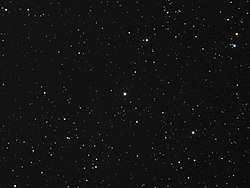HD 49674
HD 49674 is an 8th magnitude G-type main-sequence star (spectral type G5V) located approximately 144 light years away in the constellation of Auriga. It has a very similar mass to our Sun. It is orbited by a recently discovered planet.[3]
 HD 49674 in optical light | |
| Observation data Epoch J2000 Equinox J2000 | |
|---|---|
| Constellation | Auriga |
| Right ascension | 06h 51m 30.514s[1] |
| Declination | +40° 52′ 03.92″[1] |
| Apparent magnitude (V) | 8.1 |
| Characteristics | |
| Spectral type | G5V |
| B−V color index | 0.729 |
| Astrometry | |
| Radial velocity (Rv) | 11.8 ± 0.3 km/s |
| Proper motion (μ) | RA: 32.23 ± 0.97[1] mas/yr Dec.: −122.70 ± 0.69[1] mas/yr |
| Parallax (π) | 22.61 ± 0.87[1] mas |
| Distance | 144 ± 6 ly (44 ± 2 pc) |
| Absolute magnitude (MV) | 8.81 |
| Details | |
| Mass | 1.07 ± 0.02[2] M☉ |
| Radius | 1.01 ± 0.01[2] R☉ |
| Luminosity | 0.96 ± 0.01[2] L☉ |
| Surface gravity (log g) | 4.46 ± 0.02[2] cgs |
| Temperature | 5702 ± 28[2] K |
| Age | 1.8 ± 1.2[2] Gyr |
| Other designations | |
| Database references | |
| SIMBAD | data |
HD 49674, and its planetary system, was chosen as part of the 2019 NameExoWorlds campaign organised by the International Astronomical Union, which assigned each country a star and planet to be named. HD 49674 was assigned to Belgium. The winning proposal named the star Nervia and the planet Eburonia, both after prominent Belgic tribes, the Nervii and Eburones respectively.[4]
Planetary system
At the time of discovery of the planet HD 49674 b in 2002, it was the least massive planet known, very close to the boundary between sub-Jupiter mass and Neptune-mass at 0.1 MJ. This planet orbits very close to the star.
| Companion (in order from star) |
Mass | Semimajor axis (AU) |
Orbital period (days) |
Eccentricity | Inclination | Radius |
|---|---|---|---|---|---|---|
| b | >0.105 ± 0.011 MJ | 0.0580 ± 0.0034 | 4.94737 ± 0.00098 | 0.087 ± 0.095 | — | — |
See also
- List of extrasolar planets
References
- van Leeuwen, F. (2007). "Validation of the new Hipparcos reduction". Astronomy and Astrophysics. 474 (2): 653–664. arXiv:0708.1752. Bibcode:2007A&A...474..653V. doi:10.1051/0004-6361:20078357. Vizier catalog entry
- Bonfanti, A.; et al. (2015). "Revising the ages of planet-hosting stars". Astronomy and Astrophysics. 575. A18. arXiv:1411.4302. Bibcode:2015A&A...575A..18B. doi:10.1051/0004-6361/201424951.
- Butler, R. Paul; et al. (2003). "Seven New Keck Planets Orbiting G and K Dwarfs". The Astrophysical Journal. 582 (1): 455–466. Bibcode:2003ApJ...582..455B. CiteSeerX 10.1.1.7.6988. doi:10.1086/344570.
- "Belgium". NameExoworlds. Retrieved 2019-12-22.
- Butler, R. P.; et al. (2006). "Catalog of Nearby Exoplanets". The Astrophysical Journal. 646 (1): 505–522. arXiv:astro-ph/0607493. Bibcode:2006ApJ...646..505B. doi:10.1086/504701.
External links
- "Notes for star HD 49674". The Extrasolar Planets Encyclopaedia. Retrieved 2008-08-23.
- HIP 32916 Catalog
- Image HD 49674